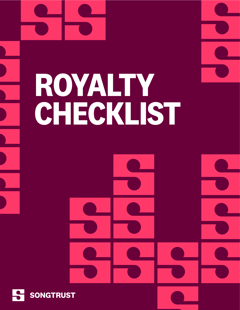Even if you’re new to the music business, you’ve probably heard about royalties: the revenue earned whenever a song is played, whether it’s live, pre-recorded, or streamed.
Sounds simple, right? It’s when people start talking about the different kinds of royalties — and how to actually go about collecting them — that the subject suddenly seems a lot more confusing.
Let’s begin at the top by defining performance royalties, one of the two major types songwriters can earn. By the end of this article, you should have a strong understanding of what performance royalties are, how they differ from mechanical royalties, and how they’re earned and collected.
Understanding Song Structure
Before we get into royalties, it’s important to remember how a song is split into two basic parts: the composition and the master recording.
The composition refers to the underlying melody, lyrics, and music. By contrast, the master recording refers to the specific recording of that piece of music. (A single composition can have many different recordings.)
In most cases, it’s the songwriters who created the song who have ownership of the composition or publishing, while the master recording is partially or fully owned by a record label or distributor.
The composition breaks down again, into two royalty types: performance and mechanical.
Performance vs Mechanical
In the simplest terms, performance royalties are earned whenever a song is performed in public. This doesn’t just include live performances in a literal sense; it also means the performance of a song recording, such as played on broadcast or satellite radio, over the sound system in a bar or gym, or streamed over a digital service like Apple Music or Spotify.
Some of the ways songs earn performance royalties include:
-
TV (a show, film or commercial broadcast that includes music, not to be confused with sync fees for song placements)
-
Radio (broadcast, streaming, and satellite)
-
Live venues
-
Restaurants
-
Bars
-
Elevator music services
-
Supermarkets
-
Clothing stores
-
Gyms
-
Jukeboxes
You might be wondering how performance royalties differ from mechanical royalties, if they’re both owed to the composition owner. Well, mechanical royalties are earned by the reproduction — physical or digital — of a piece of music. This includes digital downloads, CDs, and vinyl records, as well as online streams.
Historically, mechanical royalties have been paid by labels, distributors and mechanical agencies to the copyright owner of a piece of music. But with the passage of the Music Modernization Act in 2018, a new governing body called The Mechanical Licensing Collective (The MLC) has become the U.S.’s leading administrator of blanket mechanical licenses and payouts to songwriters, composers, lyricists and publishers. In other countries, Mechanical Rights Organizations (MROs) or Collective Management Organzations (CMOs) are responsible for collecting mechanical royalties.
For more information on how mechanical royalties work, check out this blog post.
Who Collects My Royalties?
In the most general terms, any time your composition is used, it earns performance royalties. These royalties are tracked and collected by a system of pay sources and collection societies who compare the tracked information to the registrations in their systems and assign those royalties to the correct owner. They then pay those royalties out directly to the songwriter and their publishers. It seems simple, but as you dig deeper, it quickly becomes much more complex.
In the U.S., pay sources and collection societies like ASCAP and BMI — also referred to as Performing Rights Organizations (PROs) — track and collect performances in their territories, and pay royalties directly to the rights owners who have properly affiliated and registered their songs.
Much of this money comes from charging venues an annual fee based on such key factors as their capacity, location, and revenue. A similar rule applies to radio and television stations, which pay a blanket license fee based on their market share, audience size, and revenue.
Outside of the U.S., the system for royalty collection varies based on the country or territory. PROs or another common pay source is known as Collection Management Organizations (CMOs) do the work of tracking and collecting royalties. The major difference between these two types of sources is that CMOs also collect mechanical royalties. As we’ve mentioned before, these processes can get complicated and time-consuming when it’s spread across multiple countries and continents.
As for how all of this compares to mechanical royalties, U.S. licenses are administered and maintained by Mechanical Rights Organizations (MROs) such as the Harry Fox Agency (HFA) and The MLC. Outside of the U.S., collection is facilitated by CMOs. This often requires rights owners to be affiliated with each CMO — yet another potentially lengthy process.
Our goal is to make the business of collecting all your global performance and mechanical royalties as simple, intuitive, and hassle-free as possible. If coordinating with all of the different entities — from PROs to CMOs to MROs — seems like more work than you want to take on, we urge you to familiarize yourself with Songtrust and what we could do for you. You may find that having a partner to help you track down and utilize all the different ways to earn royalties is more than worth it.


%20Two%20Halves%20of%20A%20Song.png?width=800&name=(T)%20Two%20Halves%20of%20A%20Song.png)




